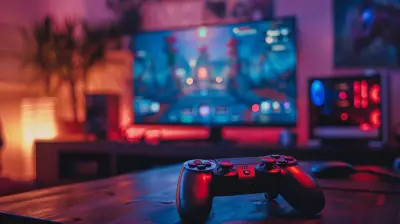How to Read Your Opponent and Predict Their Moves
11 June 2025
Whether you're sitting at a poker table, squaring off in a fighting game, or deep into a strategy board game, one thing separates the good players from the great ones: the ability to read opponents like a book and predict their next move before they even make it. Sounds like a superpower, right?
Well, it kind of is. But here's the kicker—you can develop this skill with time, practice, and the right mindset. And that’s exactly what we’re going to break down in this article. So grab your controller, cards, or chessboard, and let’s dive into the psychology, tactics, and subtle cues that can give you the upper hand.
Why Reading Your Opponent Matters
Before we jump into the “how,” let’s talk about the “why.” What makes this skill such a game-changer?Think about it: if you can guess what your opponent’s about to do, you can counter their moves, trap them, manipulate them, or just stay one step ahead. It’s like having a map in a maze while everyone else is feeling around in the dark.
In games of skill (like chess, fighting games, card games), reading your opponent is as important as mastering the mechanics. It’s no longer about just reacting—it’s about controlling the flow of the game.
The Psychology Behind Decision Making
1. People Are Predictable… Kind Of
Here’s a little secret: most people follow patterns, even when they think they’re being unpredictable. Our brains are wired to look for consistency and minimize risk. This means that with careful observation, you can start to notice habits.Let’s say your opponent always gets aggressive after losing a round. That’s a pattern—a tell. Once you catch it, you can bait them into making the same mistake over and over again.
2. Risk and Reward Drive Behavior
Players make decisions based on their perceived risk and potential reward. Understanding this basic concept gives you a window into their thought process.Ask yourself: What’s at stake for them right now? Are they desperate? Confident? Frustrated? Emotion plays a big role in decision-making, and emotional players are often the easiest to read.
Step-by-Step: How to Read Your Opponent
Alright, now for the meat and potatoes. Let’s break down how you can actually read your opponent and anticipate their next move.1. Start by Observing
Sounds obvious, right? But you'd be surprised how often players get tunnel vision and forget to watch their opponent closely.Before you make any assumptions, take a few rounds, turns, or hands to just observe. Don’t get fancy, don’t overthink it—just pay attention to what they do and how they do it.
- Do they always play aggressively?
- Do they back off when under pressure?
- Are they repeating the same move or strategy?
Jot down mental notes or even keep a notepad if you're playing online or in a poker game. The goal is to find patterns.
2. Identify Their Patterns and Habits
Humans are creatures of habit. If someone wins using a certain move, they’ll often go back to it again and again. If they get punished for a risky choice, they might avoid it for a while.The trick is to watch the rhythm of their decisions and how they adapt to wins or losses. For example:
- In a fighting game: Do they always follow a block with a grab?
- In chess: Do they always castle early?
- In poker: Do they bet big only when they’ve got a strong hand?
Once you spot a habit, you can exploit it.
3. Analyze Their Personality Type
Yes, their personality comes into play too. Some players are naturally more aggressive. Others are more cautious. Recognizing this from the get-go helps you narrow down their potential choices.Let’s say you’re in a real-time strategy game. A cautious player is unlikely to rush in early, while an aggressive one may overcommit at the start.
Understanding their mindset gives you a psychological map of what they’re likely to do under pressure or when they’re confident.
4. Use Baiting to Test Reactions
Want to really figure someone out? Try baiting.Baiting is the art of creating a fake opportunity and seeing how your opponent reacts. It’s like setting a trap just to watch how they move.
- In card games: Act like you're bluffing and see if they call.
- In MOBAs: Leave an objective open and watch how they approach it.
- In fighting games: Whiff a move purposely and see what they throw out in response.
This doesn't just help you read them—it helps you control them.
5. Watch Their Body Language (If Playing in Person)
Non-verbal cues can be gold. In face-to-face games, body language often reveals what a player is thinking before they act.Look for:
- Tension in their shoulders or jaw
- Fidgeting or restlessness
- Eye movement when they’re thinking too hard
- Smirks or raised eyebrows (yes, those can be tells)
These micro-behaviors can give you an early clue as to whether they’re confident, worried, bluffing, or clueless.
6. Use Timing and Tempo Against Them
Tempo is the pace at which the game moves. If you control the tempo, you control the match.Think of tempo like a rhythm—if your opponent always plays on-beat, you can disrupt it by speeding things up or slowing them down.
For example, in fighting games or even turn-based games, change your rhythm. Throw in pauses, sudden attacks, or odd patterns just to throw them off. A confused opponent is easier to read.
Predicting Moves: The Next Level
Now that you’re getting a read on your opponent, let’s shift gears and talk about predicting moves before they happen. This is where strategy meets intuition.1. Use Game Theory Basics
Game theory isn’t just for economists—it’s perfect for competitive gaming.The simplest model is the "best response" concept. That means you assume your opponent is optimizing their next move to counter yours. If you know what they think your move is, you can plan a step ahead.
It’s like chess: if your opponent knows you'll attack the left flank, they will defend it—so, fake the attack and strike on the right.
2. Don’t Just Predict—Force the Prediction
This part sounds sneaky, and that’s because it is.Make your play so convincing that your opponent is almost forced to react in a certain way. This works especially well against reactive players.
Control the narrative, set the bait, and when they bite, punish hard.
3. Think in Probabilities
No prediction is 100% guaranteed, but you can play the odds.If someone does “X” nine out of ten times in a certain situation, it’s a safe bet they’ll do it the tenth time—unless they’re trying to mix it up.
Create mental models like:
- “If they’re low on health, they always turtle.”
- “When ahead, they push too hard.”
Use that data to inform your play.
Mistakes to Avoid When Reading Opponents
Reading opponents isn’t foolproof. Here are some pitfalls to watch out for:1. Overthinking
Overanalyzing can lead to what’s called “analysis paralysis.” You get so caught up in possibilities that you miss the obvious.Keep it simple. Trust your instincts once you’ve got solid data.
2. Assuming Players Don't Adapt
Don’t get too comfortable reading patterns. Good players will adjust when they realize you’ve figured them out. That’s why you should keep your game fresh too.Change your own patterns, switch strategies, and stay unpredictable.
3. Ignoring Context
Reading someone’s behavior in a vacuum is a bad idea. Always pay attention to the game’s context—score, time left, previous rounds, stakes, etc.A player might take bigger risks when they’re desperate or play safe when they’re ahead. Context changes everything.
Practice Makes Perfect
Like any skill, reading your opponent takes practice. The more you play and actively try to read and predict, the sharper your instincts will get.Start small. Focus on just one thing at a time—like body language or risk patterns. Once you master that, add another layer. Over time, your ability to decode your opponent will become second nature.
Final Thoughts
Reading your opponent and predicting their moves isn’t just about being clever—it’s about being observant, patient, and strategic. It’s almost like solving a puzzle where the pieces keep moving.Whether you’re gaming casually or stepping into competitive play, mastering this skill will elevate your performance and give you a serious edge. Remember, it’s not just about reacting—it’s about making your move before they even make theirs.
Now get out there and start reading like a pro.
all images in this post were generated using AI tools
Category:
Fighting GamesAuthor:

Jack McKinstry
Discussion
rate this article
2 comments
Kylie Ruiz
Fascinating insights! How can psychological cues enhance our ability to predict opponents’ moves in different game scenarios?
June 17, 2025 at 4:05 PM

Jack McKinstry
Thank you! Psychological cues, such as body language and facial expressions, can reveal an opponent's confidence and intentions, allowing players to anticipate moves more accurately. Observing these cues helps refine strategies and improve decision-making in various game scenarios.
Faryn McDowell
Great insights! Truly helpful for players.
June 11, 2025 at 4:25 AM

Jack McKinstry
Thank you! I'm glad you found it helpful!


